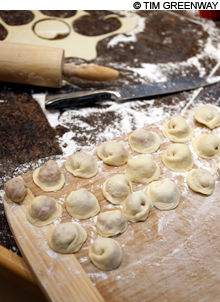
IN PROGRESS Pelmeni ready to be cooked. |
My friend's family only eats meat that he hunts: duck, venison, and moose. Because prime cuts on these animals are so few, ground meat is usually what the family has to work with. I guess I was feeling sorry for them. What's for dinner? Chili. What's for dinner? Sausage. What's for dinner? Chili. What's for dinner? Sausage. After my latest cooking lesson in an immigrant's kitchen, I wanted to bust down that family's door and rescue them, crying, "How about some Russian ravioli?"Yulia Converse taught me how to make it. The dish in Russian is called pelmeni. Much like potstickers, ravioli, wontons, gyoza, perogis, and dozens of other Asian and European foods under different names, pelmeni are little packets of ground meat, wrapped in dough, and boiled, then sometimes fried. Legend has it, pelmeni came to Russia by way of Mongolia. Yulia explained, "Hunters would get an animal, and the whole village would make pelmeni." The hunters would come home with their elk, deer, sheep, ibex, gazelle, wild boar, and/or auroch (the now-extinct ancestor to domestic cattle) and the wives would all gather to help make hundreds, even thousands, of pelmeni. Some of the women would make the dough out of flour, egg, and water, roll the dough out into sheets a millimeter thick and cut circles the size of a teacup rim. Others would mix the ground meat with minced onions, salt, and pepper, and put a teaspoon of meat on each circle of dough. The last group would fold the dough around the meat and press the bundles closed. The villagers would then keep pelmeni frozen outside and grab them to cook as needed. A mixture of pork and beef is the most popular filling today.
I wonder if the Mongolians invented the form, or if it was the Chinese before them, the Romans or some other peoples. I'm thinking the form has to be about as old as flour and eggs, so we're talking as far back as 6000 BCE. Yulia got her recipe from a red journal filled with neatly handwritten Russian scripts. Her grandmother had started writing recipes in the journal for Yulia, and then gave it to Yulia to add to. The journal is a place to record, as Yulia called it, "perfect proportions," like how much flour and water and egg to use to get the right dough consistency.
Even for non-hunting grocery shoppers like me, pelmeni make a great snack or first course. The ideal way to make these would be to invite some friends over, assemble them together like the ol' villagers used to do, freeze them on a tray, and then store Ziplocs of them in your freezer. Then when someone's hungry, you just boil water with some salt, a bay leaf, and peppercorns, throw the pelmeni in and let them cook for three to five minutes after they start floating. Yulia serves hers hot, glistening with cooking broth, a dollop of sour cream or butter melting under a sprinkling of fresh dill. Her son, however, usually complains of the dill, "Why do you always put grass on top?" In summer, Yulia's mother likes pelmeni with vinegar. In winter, she adds bouillon to the cooking broth and has a bowl of pelmeni in broth. As for me, I think I will be a boiled, butter-and-dill girl. I loved the firm, slippery quality of the nuggets, a texture in my experience only homemade egg-and-flour pasta can achieve.